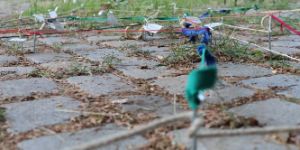Cooperation Partner Yeşil Çember

Network meeting on the Gropius Bau’s Südplatz © Eliza Levinson
Neighbourhood Projects
A special feature of the Gropius Bau is its location. It is an important point of reference for the programme and educational projects. The opening up of the institution for its various neighbours is the main aim. This education work is fundamentally collaborative and based on current and future collaborations with intercultural, intergenerational and queer neighbourhood initiatives.
The Gropius Bau is located between historical sites, government buildings, tourist attractions and offices. This environment is not an ordinary “neighbourhood” with every day, neighbourly life. Therefore, exchange with the Gropius Bau’s neighbourhood extends into Kreuzberg’s residential areas with the aim of bringing various facets of life in this area into the building, to gradually build bridges between the urban society and the Gropius Bau. This exchange is driven by experience and stories.
Current Projects
Resonance Room
The Resonance Room collects local knowledge and experiences about mental health in Berlin. Since September 2021, a number of projects have been questioning the understanding of and approach to mental health in the city: How do individual health and society interact? How does history affect the present time? What forms of care, solidarity and community are designed and practised in urban society? The resonance of civic actors from the neighbourhood, Berlin academics and multipliers from social and cultural work forms an interdisciplinary urban research, which invites participatory learning processes. As a place of meeting, the Resonance Room gathers different voices and engages them in dialogue.